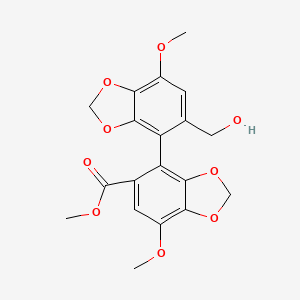Ferroptosis-centered Drug Response Information
General Information of the Drug (ID: ferrodrug0250)
| Name |
Bicyclol
|
||||
|---|---|---|---|---|---|
| Synonyms |
bicyclol; 118159-48-1; Methyl 5'-(hydroxymethyl)-7,7'-dimethoxy-[4,4'-bibenzo[d][1,3]dioxole]-5-carboxylate; Bicyclol [WHO-DD]; SY801; 9734122TH2; 4,4'-Bi-1,3-benzodioxole)-5-carboxylic acid, 5'-(hydroxymethyl)-7,7'-dimethoxy-, methyl ester; 5'-(hydroxymethyl)-7,7'-dimethoxy-[4,4'-bi-1,3-benzodioxole]-5-carboxylic acid, methyl ester; UNII-9734122TH2; SY 801; methyl 4-[5-(hydroxymethyl)-7-methoxy-1,3-benzodioxol-4-yl]-7-methoxy-1,3-benzodioxole-5-carboxylate; CHEMBL482035; SCHEMBL9600725; Bicyclol, >=98% (HPLC); DTXSID30152026; BCP25554; HY-B0766; s6453; 6-methoxycarbonyl-6'-hydroxymethyl-2,3,2',3'-bis(methylenedioxy)-4,4'-dimethoxybiphenyl; NCGC00408803-01; 4,4'-bi-(1,3-benzodioxole)-5-carboxylic acid, 5'-(hydroxymethyl)-7,7'-dimethoxy-, methyl ester; AS-16866; F85022; J-003718; Q27271958
Click to Show/Hide
|
||||
| Structure |
 |
||||
| Formula |
C19H18O9
|
||||
| IUPAC Name |
methyl 4-[5-(hydroxymethyl)-7-methoxy-1,3-benzodioxol-4-yl]-7-methoxy-1,3-benzodioxole-5-carboxylate
|
||||
| Canonical SMILES |
COC1=C2C(=C(C(=C1)CO)C3=C4C(=C(C=C3C(=O)OC)OC)OCO4)OCO2
|
||||
| InChI |
InChI=1S/C19H18O9/c1-22-11-4-9(6-20)13(17-15(11)25-7-27-17)14-10(19(21)24-3)5-12(23-2)16-18(14)28-8-26-16/h4-5,20H,6-8H2,1-3H3
|
||||
| InChIKey |
KXMTXZACPVCDMH-UHFFFAOYSA-N
|
||||
| PubChem CID | |||||
Full List of Ferroptosis Target Related to This Drug
Phospholipid hydroperoxide glutathione peroxidase (GPX4)
| In total 1 item(s) under this Target | |||||
| Experiment 1 Reporting the Ferroptosis-centered Drug Act on This Target | [1] | ||||
| Target for Ferroptosis | Suppressor | ||||
| Responsed Disease | Injury of intra-abdominal organs | ICD-11: NB91 | |||
| Pathway Response | Ferroptosis | hsa04216 | |||
| Fatty acid metabolism | hsa01212 | ||||
| Cell Process | Cell ferroptosis | ||||
| In Vitro Model | L-02 cells | Endocervical adenocarcinoma | Homo sapiens | CVCL_6926 | |
| In Vivo Model |
The mice were treated with intraperitoneal administration (i.p.) of oil (control group) or a mixture of CCl4 (50%) and oil (50%) at a dosage of 2 ml/kg body weight. In the bicyclol-treated group, mice accepted administration of 200 mg/kg (using 0.5% carboxymethyl cellulose as solvent) by gavage three times a day 1 h before CCl4 exposure, while other groups accepted vehicles of the equal volume. Fer-1 was prepared in DMSO (5 mg/kg), andi.p. injected into mice once 1 h before CCl4 exposure. The dosage of bicyclol was consistent with our previous work. The mice were then sacrificed to collect liver and serum samples after 24 or 48 h.
Click to Show/Hide
|
||||
| Response regulation | Bicyclol exerted its hepatoprotection by preventing the aforesaid ferroptotic process. Furthermore, bicyclol alleviated erastin-induced cellular inviability, destruction, and lipid peroxidation in vitro. Knockdown of GPX4 diminished these protective activities against perturbations associated with ferroptosis in L-O2 hepatocytes. Additionally, Nrf2 silencing drastically reduced GPX4 levels, and further impeded the medicinal effects of bicyclol. In summary, positively regulating Nrf2-GPX4 axis by bicyclol can prevent ferroptosis in CCl4-induced acute liver injury in mice. | ||||
Nuclear factor erythroid 2-related factor 2 (NFE2L2)
| In total 1 item(s) under this Target | |||||
| Experiment 1 Reporting the Ferroptosis-centered Drug Act on This Target | [1] | ||||
| Target for Ferroptosis | Marker/Suppressor | ||||
| Responsed Disease | Injury of intra-abdominal organs | ICD-11: NB91 | |||
| Pathway Response | Ferroptosis | hsa04216 | |||
| Fatty acid metabolism | hsa01212 | ||||
| Cell Process | Cell ferroptosis | ||||
| In Vitro Model | L-02 cells | Endocervical adenocarcinoma | Homo sapiens | CVCL_6926 | |
| In Vivo Model |
The mice were treated with intraperitoneal administration (i.p.) of oil (control group) or a mixture of CCl4 (50%) and oil (50%) at a dosage of 2 ml/kg body weight. In the bicyclol-treated group, mice accepted administration of 200 mg/kg (using 0.5% carboxymethyl cellulose as solvent) by gavage three times a day 1 h before CCl4 exposure, while other groups accepted vehicles of the equal volume. Fer-1 was prepared in DMSO (5 mg/kg), andi.p. injected into mice once 1 h before CCl4 exposure. The dosage of bicyclol was consistent with our previous work. The mice were then sacrificed to collect liver and serum samples after 24 or 48 h.
Click to Show/Hide
|
||||
| Response regulation | Bicyclol exerted its hepatoprotection by preventing the aforesaid ferroptotic process. Furthermore, bicyclol alleviated erastin-induced cellular inviability, destruction, and lipid peroxidation in vitro. Knockdown of GPX4 diminished these protective activities against perturbations associated with ferroptosis in L-O2 hepatocytes. Additionally, Nrf2 silencing drastically reduced GPX4 levels, and further impeded the medicinal effects of bicyclol. In summary, positively regulating Nrf2-GPX4 axis by bicyclol can prevent ferroptosis in CCl4-induced acute liver injury in mice. | ||||
